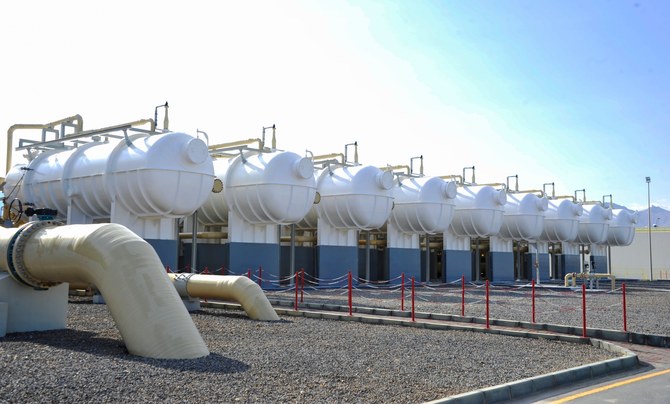
For decades, the countries of the Gulf Cooperation Council have been using desalination to support their water usage. Despite the efforts made by Gulf governments to diversify their water supplies, desalination plants remain the most critical process for meeting growing demand. As a result, their high financial and environmental costs could prove unsustainable in the medium and long terms.
Removing salt and minerals to produce freshwater for human, industrial and agricultural use, this technology has transformed life in a region that has been characterized by drought and water scarcity since antiquity. Unsurprisingly, such access to water has cradled exponential population growth, leading to increased water demand. Going forward, the increased costs of desalination, both financial and environmental, will require drastic societal changes in terms of behavior to offset.
The Gulf states have some of the lowest annual rainfall levels in the world, coupled with high evaporation rates. Saudi Arabia endures the most extreme levels, with annual rainfall below 150 millimeters, coupled with an extreme evaporation rate of more than 95 percent of surface freshwater availability.
However, the Gulf region also has one of the highest global rates of water consumption. For example, the 300 liters of daily per capita water consumption in the UAE and 400-plus liters in Bahrain and Qatar pale in comparison to Germany’s 115 liters. With the Gulf’s population expected to grow by about 40 percent to 71 million by 2050, the long-term viability of desalination and its associated costs should be under review. Instead, it is on the rise.
When compared with other water recycling technologies, desalination remains significantly more energy intensive
Zaid M. Belbagi
At 97.2 million cubic meters per day, the Gulf region accounts for 40 percent of global desalinated water capacity. It is expected to use as much as 300 million cubic meters by 2050. The two processes used, thermal and membrane desalination, are hugely energy intensive. With tens of billions of dollars allocated for both desalination and water storage across the region, the cost of increasing the water supply is already being felt not only from an infrastructural perspective, but also in terms of the cost to regional governments of subsidizing water and the energy used to desalinate it.
Given that the Middle East is already warming at double the global average, sustaining long-term fossil fuel combustion for the desalination process is similarly detrimental to the local climate, which is already becoming less habitable year on year. In 2021, the Saudi Saline Water Conversion Corporation achieved the lowest-energy desalination process in the world, using 2.27 kilowatt-hours per cubic meter of treated water. That being said, when compared with other water recycling technologies, desalination remains significantly more energy intensive.
While the financial costs are expected to rise, the uncalculated costs are those of the effect on the environment. Brine, comprising the salts extracted from seawater during the desalination process, is incredibly harmful to marine ecosystems. Not only is the increased saltwater detrimental to the microbiology that supports the rest of marine life, the toxic byproducts of the process are similarly harmful.
As a result, the Arabian Gulf is now one of the most anthropogenically affected regions in the world. Put in context, it is no accident that the GCC states are responsible for 60 percent of global desalination capacity, while the UAE, Kuwait, Qatar and Saudi Arabia account for 55 percent of the world’s brine production. With the Gulf countries having committed to producing more of their energy from renewables, how they will reconcile this with growing water demand will be a great challenge.
Switching to renewable desalination will need to be coupled with a change in consumption habits
Zaid M. Belbagi
In circumstances where solar-powered desalination is limited to daylight hours, and given the region’s high levels of dust intensity, switching to renewable desalination will need to be coupled with a change in consumption habits. This was highlighted in a warning by the World Bank late last year, given that the shallow Gulf waters are naturally saltier than others due to the high evaporation rates and limited inflow of freshwater. It stated that “a vicious cycle” of unsustainability is being caused, as the more hypersaline waste is deposited in the sea, the more energy is required to remove this salt in successive rounds of desalination.
Although new technologies will, in time, allow for less environmentally harmful desalination processes, they alone will not offset the issue of rising demand. Generous subsidies keep the price of expensively desalinated water artificially low. These subsidies also negatively impact the adoption of practices to best manage and save wastewater by citizens. A reduction in the subsidies would eventually change habits, but it is highly unlikely that these alone would resolve the region’s chronic water scarcity.
The Gulf region is severely exposed to the effects of climate change and, within this context, the water resource capacity in nations across the region is expected to drop by more than half by 2030. Integrating a gradual weaning-off of subsidies with renewable-powered desalination, alongside better management of wastewater, can curb some of the challenges the region faces. For example, Dubai aims to produce 100 percent of its desalinated water supply from a mixture of renewables and waste heat by 2030, in an effort to lead the region from this perspective.
Nevertheless, as long as new desalination plants continue to be built in the region and investments in more sustainable models are lacking, there are still fundamental issues with the long-term viability of the current model of meeting growing water demand.
Zaid M. Belbagi is a political commentator and an adviser to private clients between London and the GCC. Twitter: @Moulay_Zaid












